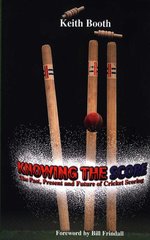Knowing the Score
David Taylor |Published: 1999
Pages: 202
Author: Booth, Keith
Publisher: Mainstream
Rating: 3 stars

This book, by the Surrey scorer Keith Booth, is subtitled ‘The Past, Present and Future of Cricket Scoring’ and is, as the cover blurb states, a unique book. Booth, who has also scored for England on tour (and whose wife Jennifer scores for Surrey 2nds) is certainly qualified to write it. The word ‘score’ as well as describing the set of figures which tell us the state of the game, also means to carve a line or notch, and of course notches on a stick were the first, rudimentary means of recording the total in the earliest organised matches, the scorers being known as ‘notchers’.
Once the gentry becamer involved and money staked on matches – and Booth notes that in the 18th century cricket ‘had become as inextricably linked with betting as horse-racing is today’ – it became essential to keep an accurate and detailed record. While the book is, unsurprisingly, not generously illustrated some of these early score sheets – which gave way to score books in the following century, are depicted.
One interesting feature emerges early on. Much as in the early days of West Indies cricket, batsmen were usually amateurs and bowlers professionals, and this was reflected in the records. As well as having their full name or initials, and in many cases titles noted, the batsmen’s feats and figures were recorded long before those of the bowlers. Early cards show how the batsman was out and how many he made, but not the name of the bowler or fielder responsible for his dismissal. Not until well into the 19th century do scorecards become democratic, with the appearance of the first bowling analysis.
Scoring methods have developed along with the game and Booth takes us through the various methods used, indicating where improvements and amendments have been made. The most marked departures from the book that many of us would have used in school or club games have been ‘linear’ scoring (thought to have been devised by the Australian scorer and baggage man William Ferguson, a system in which each over is represented by a line, and enables a calculation of balls faced by each batsman), and the introduction, not always welcome, of computers into county grounds in the mid-1990s.
Booth also gives us a chapter entitled ‘So … what do scorers do?’ in which he tells us about scorers of the past, and the way in which they were usually treated as poor relations of umpires and players (he gives an account of a very brusque dismissal of Ferguson on his first day at Lord’s). When I reviewed the Duckworth Lewis book last year I expressed the view that it was very different from most titles, and of necessarily limited appeal, and the same goes for this work, although the writer has a pleasing style and manages to make his subject matter a good deal more interesting than you might expect.






Leave a comment